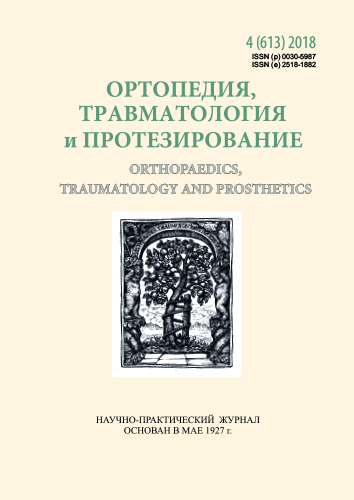Histological characteristic of destructive changes in the shoulder joint at arthrosis model
DOI:
https://doi.org/10.15674/0030-59872018441-47Keywords:
arthrosis, shoulder joint, impaired biomechanics, articular cartilage, subchondral bone, guinea pigsAbstract
Late treatment of shoulder joint arthrosis and insufficient assessment of pathogenetic components in the appearance and progression of pathological changes in the cartilage lead to the rapid progression of the disease. Traumatic damage of the joint capsule-ligamentous apparatus and impaired mobility are considered one of the main factors for the development of this pathology. But the disturbance of the shoulder joint biomechanics
as a factor in the development of arthrosis remains not fully understood. Objective: to study the dynamics of structural changes in the articular surface of the humerus head in the guinea pigs model, when we reproduced the disturbance of biomechanics and the formation of shoulder joint contracture. Methods: the experiments were carried out on guinea pigs weighing 380–420 g, 5 months old. Reproduced model of surgical limitation of joint mobility, which caused the formation of contracture. Histology and scanning electron microscopy examined the condition of the articular cartilage and subchondral bone after 30, 60 and 90 days after modeling. Results: 30 days after surgery in the articular cartilage, degenerative changes were detected, which progressed with the formation of a joint contracture by the 90th day of observation. Destructive changes in articular cartilage after 60 days were manifested by the destruction of its superficial zone, disturbances in the structure of the matrix and chondrocytes, which led to sclerosis of the subchondral layer after 60 and 90 days. The obtained data confirmed the hypothesis that impaired biomechanics and abnormal
loads are an independent factor in the development of arthrosis of the shoulder joint. The most critical period was from 30 up to 60 days. Conclusions: the first 30 days after the disturbance of the biomechanics of the shoulder joint can be considered as a therapeutic window for the medical and functional correction of the pathological process.
References
- Chillemi, C., & Franceschini, V. (2013). Shoulder osteoarthritis. Arthritis, 2013, 370231. doi: https://doi.org/10.1155/2013/370231
- Birrell, F. (2011). Osteoarthritis: pathogenesis and prospects for treatment [web source]. Reports on the Rheumatic Diseases. Series 6, Topical Reviews № 10. Retrieved from: www.arthritisresearchuk.org/medical-professional-info
- Prieto-Alhambra, D., Judge, A., Javaid, M. K., Cooper, C., Diez-Perez, A., & Arden, N. K. (2014). Incidence and risk factors for clinically diagnosed knee, hip and hand osteoarthritis: influences of age, gender and osteoarthritis affecting other joints. Annals of the Rheumatic Diseases, 73 (9), 1659–1664. doi:https://doi.org/10.1136/annrheumdis-2013-203355
- Reuther, K. E., Thomas, S. J., Tucker, J. J., Sarver, J. J., Gray, C. F., Rooney, S. I., … Soslowsky, L. J. (2014). Disruption of the anterior-posterior rotator cuff force balance alters joint function and leads to joint damage in a rat model. Journal of Orthopaedic Research, 32 (5), 638–644. doi:https://doi.org/10.1002/jor.22586
- Sergienko, R. O., Strafun, S. S., Savosko, S. I., & Makarenko, A. M. (2016). Topography and dynamics of deforming osteoarthrosis of the shoulder joint according to the results of ultrastructural study. Herald of Orthopedics, Traumatology and Prosthetics, 4, 4–11. (in Ukrainian)
- Kramer, E. J., Bodendorfer, B. M., Laron, D., Wong, J., Kim, H. T., Liu, X., & Feeley, B. T. (2013). Evaluation of cartilage degeneration in a rat model of rotator cuff tear arthropathy. Journal of Shoulder and Elbow Surgery, 22 (12), 1702–1709. doi:https://doi.org/10.1016/j.jse.2013.03.014
- Sarkisov, D. S., Perov, Yu. L. (1996). Microscopic technique: Manual. Moscow: Medicine. (in Russian)
- Wang, C., Wang, X., Xu, X., Yuan, X., Gou, W., Wang, A., … Lu, S. (2014). Bone microstructure and regional distribution of osteoblast and osteoclast activity in the osteonecrotic femoral head. PLoS ONE, 9 (5), e96361. doi:https://doi.org/10.1371/journal.pone.0096361
- Zhang, S., Cao, W., Wei, K., Liu, X., Xu, Y., Yang, C., … Chen, W. (2013). Expression of VEGF-receptors in TMJ synovium of rabbits with experimentally induced internal derangement. British Journal of Oral and Maxillofacial Surgery, 51 (1), 69–73. doi:https://doi.org/10.1016/j.bjoms.2012.01.014
- Liu, J., Dai, J., Wang, Y., Lai, S., & Wang, S. (2017). Significance of new blood vessels in the pathogenesis of temporomandibular joint osteoarthritis. Experimental and Therapeutic Medicine, 13 (5), 2325–2331. doi:https://doi.org/10.3892/etm.2017.4234
Downloads
How to Cite
Issue
Section
License
Copyright (c) 2019 Ruslan Sergienko, Sergiy Strafun, Sergiy Savosko, Oleksandr Makarenko

This work is licensed under a Creative Commons Attribution 4.0 International License.
The authors retain the right of authorship of their manuscript and pass the journal the right of the first publication of this article, which automatically become available from the date of publication under the terms of Creative Commons Attribution License, which allows others to freely distribute the published manuscript with mandatory linking to authors of the original research and the first publication of this one in this journal.
Authors have the right to enter into a separate supplemental agreement on the additional non-exclusive distribution of manuscript in the form in which it was published by the journal (i.e. to put work in electronic storage of an institution or publish as a part of the book) while maintaining the reference to the first publication of the manuscript in this journal.
The editorial policy of the journal allows authors and encourages manuscript accommodation online (i.e. in storage of an institution or on the personal websites) as before submission of the manuscript to the editorial office, and during its editorial processing because it contributes to productive scientific discussion and positively affects the efficiency and dynamics of the published manuscript citation (see The Effect of Open Access).














